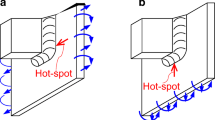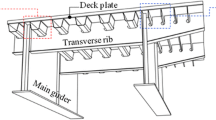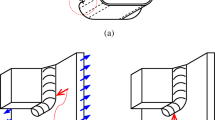Abstract
In this study, the fatigue performances of longitudinal-to-transverse rib connections in orthotropic steel decks were assessed by finite element analysis and the hot spot stress approach. Orthotropic steel decks have the following features: (1) stress conditions around welded connections vary depending on the longitudinal and transverse positions of the tire loads, (2) both bending and membrane stresses act on the complex formed connections, and (3) the structures contain comparatively thin steel plates of 6–16 mm thickness. To assess the fatigue performances of the connections in orthotropic steel decks, the effects of traveling load, bending stress, and plate thickness were considered. As a result of the assessments, the connection with a non-slit transverse rib was evaluated to have high fatigue strength in either open or closed longitudinal rib. Finally, the fatigue performances of the connections were confirmed by fatigue tests.















Similar content being viewed by others
References
Subcommittee on Fatigue of Orthotropic Steel Bridge Deck Committee on Steel Structures (2010) Fatigue of orthotropic steel bridge deck—steel structures series 19. Japan Society of Civil Engineers, Tokyo
Gurney T (1992) Fatigue of steel bridge deck, TRL State of the art review / 8. HMSO, London
Chen WF, Duan L (2014) Bridge Engineering Handbook, Second Edition, Construction and Maintenance. CRC Press, Boca Raton
Miki C, Konishi T, Tokida H, Sasaki K (2009) Inspection and retrofitting of fatigue damaged orthotropic steel deck. Proceedings of the 2nd International Conference on Fatigue and Fracture in the Infrastructure, Philadelphia, PA, July 26-29. Lehigh University, Bethlehem
Fiedler E (2009) The development of the orthotropic roadway-plate in Germany. Stahlbau 78(8):562–576
Morinaga M, Isogami T, Chiba T (2008) Developed technologies and achieved cost reduction through the project of Tokyo-Port Seaside Bridge (no. 3) Design of the superstructure (2). Bridges and foundation engineering 42(10):40–45
Sugiyama H, Tabata A, Kasugai T, Ishi H, Inokuchi S, Kiyokawa S, Ikezue K (2014) Improving fatigue resistance of cutout on diaphragm in orthotropic steel deck. Journal of JSCE, Ser A1 70(1):18–30
Chou CC, Uang CM, Seible F (2006) Experimental evaluation of compressive behavior of orthotropic steel plates for the new San Francisco-Oakland Bay Bridge. J Bridg Eng 11(2):140–150
Serzan K, Khazem D (2004) Steel orthotropic box girder on the New Alfred Zampa Suspension Bridge across the Carquinez Strait first in the US, Proceeding of the 2004 Orthotropic Bridge Conference, Sacramento, California: 177–188, ASCE, Sacramento
Yokozeki K, Miki C (2015) Fatigue evaluation for longitudinal-to-transverse rib connection of orthotropic steel deck by using structural hot spot stress. Welding in the World. doi:10.1007/s40194-015-0272-x
Hobbacher A (2009) Recommendations for fatigue design of welded joints and components. Welding Research Council, New York
Lotsberg I, Sigurdsson G (2006) Hot spot stress S-N curve for fatigue analysis of plated structures. Journal of Offshore Mechanics and Arctic Engineering 128:330–336
Kang SW, Kim WS, Paik YM (2002) Fatigue strength of fillet welded steel structure under out-of-plane bending load. Int J Korean Welding Soc 6:33–39
Fischer C, Fricke W (2015) Consideration of stress gradient effects for complex structures in local fatigue approaches. Analysis and Design of Marine Structures - Proceedings of the 5th International Conference on Marine Structures, MARSTRUCT: 241-250, CRC Press, Balkema
Japanese Society of Steel Construction (2012) Fatigue design recommendation for steel structure. Gihodo, Tokyo
Gurney T (1995) Thickness effect in ‘Relatively thin’ welded joints. The Welding Institute, Cambridge
Kihl DP, Sarkani S (1997) Thickness effects on the fatigue strength of welded steel cruciforms. Int J Fatigue 19(1):S311–S316
Miki C, Mori T, Sakamoto K, Kashiwagi H (1987) Size effect on the fatigue strength of transverse fillet welded joints. Journal of Structural Engineering A 33:393–402
Niemi E, Koshimaki M (1997) Fatigue strength of welded joints in three types of stainless steel. Welding in the World 39(2):65–73
Marquis G, Kahonen A (1996) Fatigue testing and analysis using the hot spot method, VTT publications 239. Technical Research Center of Finland, Espoo
Miki C, Tateishi K, Yamamoto Y, Miyauchi M (1992) A study on the local stress approach to the fatigue assessment. Journal of Structural Engineering A 38:1055–1062
Anami K (2001) Fatigue strength improvement of welded joints made of high strength steel. Doctoral thesis of Tokyo Institute of Technology
Huther I, Lieurade HP, Sayhi N, Buisson R (1998) Fatigue strength of longitudinal non-load-carrying welded joints. Welding in the world 41:298–313
Sakano M, Arai M (2004) Thickness effect on fatigue strength of out-of-plane welded gusset joint. Journal of JSCE 766:351–356
Kamakura M, Nihei M, Sakaki E, Kanao M, Inagaki M (1979) Effect of specimen size on fatigue properties of SM50B non-load-carrying fillet welded joints. Journal of Japan Welding Society 48(12):46–50
Maddox SJ (2001) Recommended hot-spot stress design S-N curves for fatigue assessment of FPSOs. Proceedings of the International Offshore and Polar Engineering Conference 4:97–104
Xiao Z, Chen T, Zhao X (2012) Fatigue strength evaluation of transverse fillet welded joints subjected to bending loads. Int J Fatigue 38:57–64
Miki C, Tateishi K, Ricci JF, Kanao M (1993) A study on fatigue strength of scallop details under out-of-plane displacement, Kozo Kogaku Ronbunshu. A (Journal of Structural Engineering A) 39A:989–997
Fricke W, Doerk O (2006) Simplified approach to fatigue strength assessment of fillet-welded attachment ends. Int J Fatigue 28:141–150
Yamada K, Osonoe T, Ojio T (2007) Bending fatigue test on welded joints between vertical stiffener and deck plate. Journal of JSSC 14(55):1–8
Yagi J, Machida S, Tomita Y, Matoba M, Kawasaki T (1991) Definition of hot spot stress in welded plate type structure for fatigue assessment (1st report). Journal of the Society of Naval Architects of Japan 169:311–318
Yamaoka D, Sakano M, Natsuaki Y, Nonaka S, Nakagawa Y, Nakamura K (2010) Fatigue behavior and countermeasure of intersection between bulb ribs and lateral rib of a bridge type of orthotropic steel deck. Journal of Structural Engineering A 56:838–849
Machida S, Matoba M, Yoshinari H, Nishimura R (1992) Definition of hot spot stress in welded structure for fatigue assessment (3rd report). Journal of the Society of Naval Architects of Japan 171:477–484
Japan Road Association (2002) Recommendation for Fatigue Design of Steel Road Bridge (in Japanese). Maruzen, Tokyo
Fu G, Lourenco MI, Duanb M, Estefena SF (2016) Influence of the welding sequence on residual stress and distortion of fillet welded structures. Mar Struct 46:30–55
Acknowledgements
This work was supported by the research project funded by the following members:
IHI Infrastructure Systems Co., Ltd., JFE Engineering Corporation, JFE Steel Corporation,
KAWADA INDUSTRIES, INC., Kobe Steel, Ltd., KOMAIHALTEC Inc., Mitsui Zosen Steel Structures Engineering Co., Ltd., MIYAJI ENGINEERING CO., LTD., MM BRIDGE CO., LTD, NIPPON STEEL & SUMITOMO METAL CORPORATION, and Yokogawa Bridge Holdings Corp.
Author information
Authors and Affiliations
Corresponding author
Additional information
Recommended for publication by Commission XIII - Fatigue of Welded Components and Structures
Rights and permissions
About this article
Cite this article
Yokozeki, K., Miki, C. Fatigue assessment of various types of longitudinal-to-transverse rib connection in orthotropic steel decks. Weld World 61, 539–550 (2017). https://doi.org/10.1007/s40194-017-0426-0
Received:
Accepted:
Published:
Issue Date:
DOI: https://doi.org/10.1007/s40194-017-0426-0




